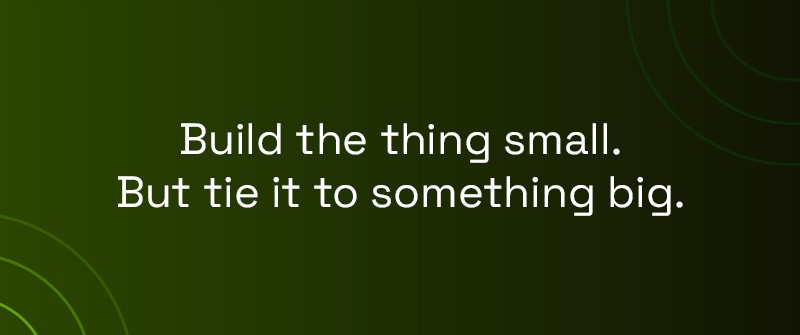
It’s not about demos. It’s about decisions, dollars, and doing the hard stuff.
AI pilots are easy to love. They’re shiny. They’re fast. They never have to deal with messy systems, cross-functional workflows, or actual business outcomes.
But scaling? That’s where things get real. This is where most AI strategies hit the wall. Not because the model is bad, but because nobody planned for what comes after the applause. Integration. Governance. ROI. Organizational patience. That’s the hard stuff, and that’s where the real payoff lives.
If you’ve already nailed the proof of concept and now you’re staring at a dozen conflicting opinions about what’s next, you’re in the right place.
We’ll break down the phases that actually get AI from sandbox to scale, share what Ford and BBVA learned the hard way, and unpack the exact questions leaders are asking in the wild.
Because the goal isn’t to impress. The goal is to move the needle, and keep it moving.
What Leaders Are Actually Asking
These aren’t hypotheticals. These are real questions pulled straight from Reddit, forums, and executive briefings:
- “Why do so many AI pilots stall?”
- “How do I know when it’s time to scale?”
- “What are the biggest risks of doing this too soon?”
- “Is it a tech problem, or a people problem?”
They’re not yes or no questions. But they all point to the same thing: scaling AI is harder than starting it. And that’s where the strategy has to shift.
The questions are valid. Confusion is common. But the answers don’t have to be complicated. In fact, the biggest risk isn’t doing AI wrong. It’s pretending the shiny pilot is the end of the journey.
So, what’s the answer?
Why do so many AI pilots stall?
Because they’re built to prove the tech works, not the business case. A solid demo doesn’t guarantee real-world value. If there’s no plan for ownership, integration, and scale from day one, the pilot dies quietly after the applause.
How do I know when it’s time to scale?
When your pilot isn’t just working technically but making decisions better. When you’ve got clean data, a clear outcome, and buy-in from the people who will live with the results. When it stops needing a babysitter.
What are the biggest risks of doing this too soon?
You burn credibility. You waste time and money. And worst of all, you train your org to stop trusting smart ideas. Scaling too early doesn’t just fail, it poisons the well.
Is it a tech problem, or a people problem?
Yes. It’s both. The tech has to work. The people have to trust it. If either side breaks down, the strategy does too.
Phase 1: Pilot with Purpose
A good pilot should prove more than technical possibility. It should prove the business value of your AI strategy.
Set clear KPIs, or key performance indicators. These are the measures that show whether you’re actually solving a business problem. Align the use case with a real problem. And stop treating the pilot like a science project. You’re not there to impress the steering committee. You’re there to answer one question: does this solve something important?
Build the thing small. But tie it to something big.

Because if your pilot isn’t already connected to dollars or decisions, scaling it won’t magically make that happen.
Phase 2: Build Technical Muscle
Here’s the part that kills most AI momentum: the model works, but the data doesn’t.
Scaling AI means integrating it into the daily mess of business systems. That means APIs, pipelines, security reviews, and all the stuff nobody wants to demo on stage.
If your infrastructure can’t support real-time data, or your data governance, meaning the rules and safeguards for how data is used, can’t handle the risk, it doesn’t matter how smart the model is.
This is where MLOps comes in. Short for machine learning operations, it’s how you keep AI from becoming a one-off science experiment. It’s the infrastructure, testing, and deployment practices that make sure your models don’t just work once. They keep working, securely and at scale. Automated testing. Version control. Deployment guardrails. It’s boring. It’s necessary. And it’s the only way the next phase doesn’t turn into chaos.
Phase 3: Drive Organizational Buy-In
You can’t scale AI in a vacuum. You need sponsors. Champions. People who don’t just approve the budget but protect the vision when it hits friction.
Train the end users early. Loop in the skeptics. Translate the model’s output into something the business actually understands.
And yes, you’re going to need change management, even if you hate the phrase. That just means helping people adapt to a new way of working. Because every time the model gets it right, someone has to trust it enough to act on it.
BBVA rolled out thousands of ChatGPT licenses across the org. They didn’t just flip a switch. They built playbooks. They created feedback loops. They made it part of the way people already work. That’s what scaling actually looks like.
Phase 4: Scale with Governance and Iteration
Scaling isn’t a finish line. It’s a feedback loop. What worked in the pilot won’t always work at scale. That’s not failure. That’s normal.
Set up guardrails. Monitor drift, which happens when your model starts getting things wrong because the data has changed. Revisit assumptions. Ford had a predictive maintenance model that worked beautifully in a lab. But it hit snags in the field because nobody accounted for how often humans override the system.
Scaling AI means building for reality. That means controls. That means context. That means iteration.
Real-World Lessons from the Field
BBVA: Scaling AI with structure, not shortcuts
BBVA rolled out thousands of ChatGPT Enterprise licenses across the organization. But this wasn’t a tech dump. It was a coordinated rollout backed by executive sponsorship, training, and process integration. Teams got playbooks. Feedback loops were built in. The tech didn’t lead. The people did. And that’s why it worked.
Ford: A pilot that worked until it didn’t
In a case study published by MIT Sloan, Ford built a predictive maintenance model that could detect equipment failure up to ten days in advance. The pilot showed huge promise. But when it came time to roll out, it fizzled. Why? The model wasn’t embedded into real workflows. Technicians ignored alerts. No one owned the outcome. A solid model with no structure around it doesn’t deliver value. It just takes up space.
Checklist: Are You Ready to Scale?
- Your pilot solved a real business problem
- You defined measurable outcomes from the start
- Your data pipelines are clean, real-time, and secure
- Your model outputs make sense to someone outside the data team
- You have execs, users, and IT aligned
- You’ve tested what happens when things go wrong
- You have someone who owns the outcome, not just the model
If you didn’t check most of those boxes, don’t panic. That’s what this checklist is for.
Let’s Call It What It Is
Scaling AI is less about fancy algorithms and more about the unsexy parts most teams avoid. It’s architecture. It’s buy-in. It’s knowing that a model that works in a demo still has to survive Monday morning.
This isn’t about building something impressive. It’s about building something that lasts. If you’re still thinking of your pilot as a test, great. But if you’re ready to treat it like a launchpad, even better.
The Bottom Line: If your AI pilot starts and ends with a proof of concept, you’re not solving a problem. You’re running a simulation.
But if you’re ready to make it real. If you’re ready to connect models to decisions, tech to outcomes, and teams to something they can trust, then you’re already ahead of the game.
Just don’t stop at the sandbox.
Ready for What’s Next?
If any of this hit home,you might need a sounding board. Someone who’s scaled the wall before. That next smart move might be a workshop, a working session, or just a conversation with someone who’s been in the trenches.
Either way, if you’re ready, we’re here to help.
Get in touch with a P3 team member